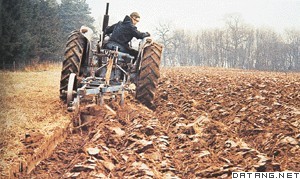1) tillage plus straw covering


翻耕覆盖秸秆
2) No-tillage with straw mulching(NTMS)


秸秆覆盖免耕(NTMS)
3) no-tillage with stubble retention


免耕秸秆覆盖
1.
Effects of no-tillage with stubble retention on soil temperature of rainfed spring wheat field;
免耕秸秆覆盖对旱作麦田土壤温度的影响
4) straw mulch


秸秆覆盖
1.
Effects of straw mulch on the growth of maize under insufficient irrigation;


非充分灌溉条件下秸秆覆盖对玉米生长的影响
2.
Requirements of water and nitrogenous fertilizer to increase winter wheat yield under straw mulch;
农田秸秆覆盖条件下冬小麦增产的水氮条件
3.
Simulation study on influence of straw mulch on soil moisture and heat of summer corn farmland;
秸秆覆盖对夏玉米农田土壤水分与热量影响的模拟研究
5) Straw cover


秸秆覆盖
1.
Straw cover not only has the obvious effect of water storage and moisture preservation,but also can improve the physical and chemical properties of soil,fertilization of arable land fertility,and reduce soil erosion,which is a measure that has very significant effect in dry farming production technology.
玉米秸秆覆盖是利用作物秸秆覆盖地表,解决保土、培肥和控制水土流失的一项旱作农业耕作措施。
2.
Therefore,the controlled traffic tillage with straw cover was adopted based on the ridge culture techniques,by changing flood irrigation to furrow irrigation to study the effect of soil water under controlled traffic tillage irrigation.
针对传统灌溉方式下大水漫灌所造成的水资源浪费,采用固定道耕作结合垄作沟灌并进行秸秆覆盖的方法,改传统耕作的大水漫灌为小水沟内侧渗灌,设置垄沟比例为2。
3.
The influence of permanent no-tillage with straw cover in long term on the change of soil total organic nitrogen had been studied in Dingxi county,one of the typical semi-arid areas in Gansu Province.
通过在定西进行秸秆覆盖免耕试验,研究了长期连续定位使用秸秆覆盖免耕对土壤中酸解有机总氮变化的累积影响。
6) straw mulching


秸秆覆盖
1.
Effects of straw mulching quantities on the growth of root and canopy of maize under different water condition;
不同水分状况下秸秆覆盖量对玉米根、冠生长的影响
2.
Effect of straw mulching on soil temperature before the greening stage of winter wheat in dryland;
旱地冬小麦返青前秸秆覆盖的土壤温度效应
3.
Study on the soil evaporation of winter wheat under different straw mulching;


秸秆覆盖条件下冬小麦棵间蒸发规律研究
补充资料:翻耕
| 翻耕 ploughing 使用犁等农具将土垡铲起、松碎并翻转的一种土壤耕作方法。通称耕地、耕田或犁田。其作用是:疏松耕层,利于纳雨贮水,促进养分转化和作物根系伸展;能将地表的作物残茬、肥料、杂草、病菌孢子、害虫卵块等埋入深土层,提高整地播种质量,抑制病、虫、杂草生长繁育。翻耕在世界农业中的应用历史悠久,范围广泛。中国在2000多年前已用犁翻耕土地。
翻耕最常用农具为铧式犁。根据犁体结构不同,性能和使用方法也不同。一般铧式犁的犁壁固定,只能向右侧翻土。耕地常分内翻法和外翻法。为平整土地,常交替使用内、外翻法进行套耕,减少垄、沟数。双向犁,采取梭形耕作法,耕后不产生垄沟,常用于坡地、水田和灌溉地。耕地深度根据作物、土壤质地和气候、季节等因素而定。一般块茎作物宜深,浅根作物相对宜浅;粘土宜深,沙土宜浅;秋耕和休闲地宜深,春耕和播前耕宜浅。世界各国耕地深度为20~25厘米。中国的实践证明,深耕结合增施有机肥料,增产效果更显著。 |
说明:补充资料仅用于学习参考,请勿用于其它任何用途。
参考词条
